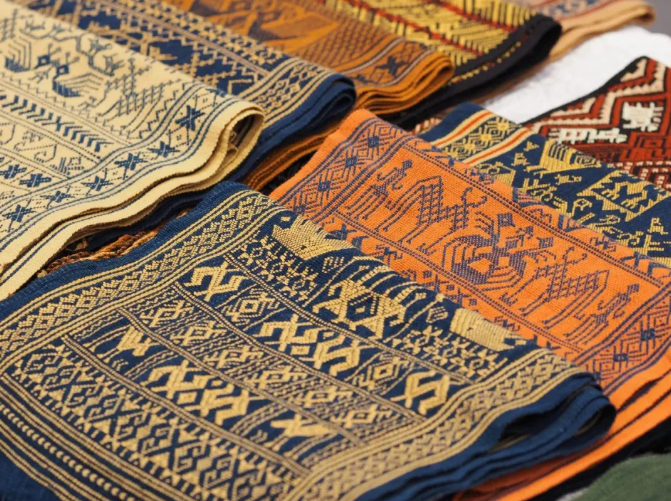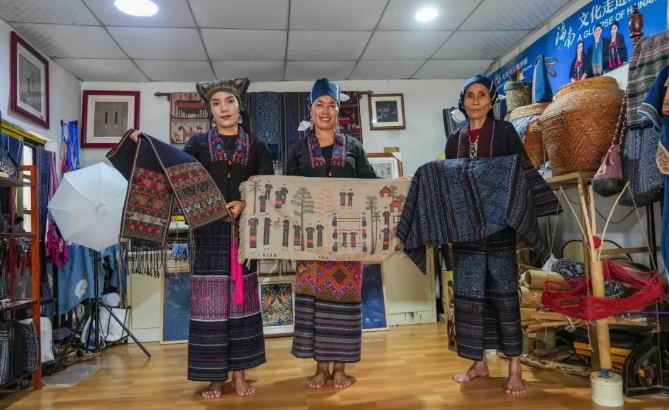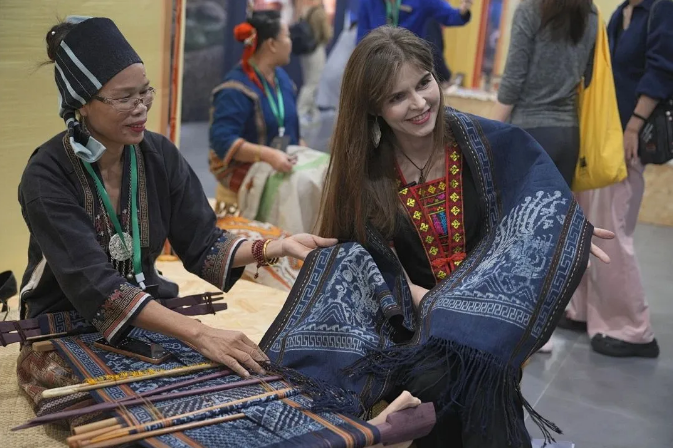/ 2024-12-12 17:43 / Culture

Li Brocade (Photo: Feng Shuo/Hainan Daily)
What does the change in status mean for Li Brocade?
In order to protect intangible cultural heritage, in 2003 UNESCO adopted the Convention for the Safeguarding of the Intangible Cultural Heritage and established the Representative List of the Intangible Cultural Heritage of Humanity and the List of Intangible Cultural Heritage in Need of Urgent Safeguarding, as well as an inventory of Good Practices, sorting the intangible cultural heritage arts according to their sustainability and conservation status.
For an art to move from the List of Intangible Cultural Heritage in Need of Urgent Safeguarding to the Representative List of the Intangible Cultural Heritage of Humanity, it must grow stronger through protection and development, must increase in sustainability, and must no longer be in danger of dying out.
The purpose of transferring an art from one list to the other is to upgrade its status and better promote the protection, passing down, and development of these intangible cultural heritage arts. In the future, the protection of the traditional Li textile techniques of spinning, dyeing, weaving and embroidering will grow more flexible, powerful, and efficient.
The traditional Li textile techniques of spinning, dyeing, weaving and embroidering were included on the first list of China's national level intangible cultural heritage in 2006, and then on the UNESCO List of Intangible Cultural Heritage in Need of Urgent Safeguarding in 2009. This unique art form has been passed down from one generation to the next for over 3,000 years, developing into an invaluable representation of human civilization.
This art is a traditional handicraft of the Li people of Hainan, who weave natural fibers such as cotton and hemp into clothing and other daily use items. Thanks to their extensive knowledge and use of plant fibers and dyes over a long period of time, the Li people gradually developed a system of fiber arts consisting of four related crafts: spinning, dyeing, weaving, and embroidering. Textiles created through the combination of these four crafts, such as head coverings, quilts, skirts, and tapestries are collectively known as Li Brocade.
The traditional arts of spinning, dyeing, weaving, and embroidering are an important carrier of Li culture. In the 1950s, there were around 50,000 women who had mastered these arts, but by the 1970s, that number had shrunk in half, and by 2009 there were only 1,000, most of whom were over seventy years of age. The art form was in a dire crisis, and in real danger of disappearing entirely.
The inclusion of the traditional Li textile techniques of spinning, dyeing, weaving and embroidering on the UNESCO List of Intangible Cultural Heritage in Need of Urgent Safeguarding meant greater protection for these arts in Hainan. Government departments at all levels sprang into action, carrying out surveys and performing preservation work, then promoting the passing down and development of the arts in a variety of ways. The living conditions of practitioners of the art were improved. Li Brocade heritage villages were recognized in Wuzhishan, Sanya, Baoting, and other parts of the island, and learning centers were opened to expand the numbers of those learning these ancient skills. The art of Li Brocade was introduced to Hainan's classrooms, where students came into contact with it, research and training programs were launched, and workstations were established where the handicraft could be put into practice.
Thanks to increasing financial investment, levels of protection, the opening of intangible cultural heritage workshops, the creation of industry alliances, and the practice of setting up raw materials bases, today there are over 20,000 active practitioners of the traditional Li textile techniques of spinning, dyeing, weaving and embroidering.

Three generations of Li Brocade artisans, Fu Baixianxiang, Fu Xianxiang, and Fu Renling (R to L), show off their Li Brocade creations in Yulong Village, Donghe Town, Dongfang. (Photo: Chen Yuancai/Hainan Daily)
Thanks to these efforts, Li Brocade has become more and more well known internationally over the last several years.
In April, 2023, Li Brocade strutted down the catwalk at the Li Brocade Fashion Show and Li cultural exchanges were held during Milan's Design Week.
In September, 2024, Wuzhishan Li Brocade appeared in the showrooms of Paris Fashion week, capturing the attention of the international fashion industry.
How can Li Brocade move from 'protection' to 'visibility'?
This is the first time for a Chinese art to be moved from the List of Intangible Cultural Heritage in Need of Urgent Safeguarding to the Representative List of the Intangible Cultural Heritage of Humanity.
Moving from the first to the second list involves more than just switching the name of the list on paper. The purposes of the two lists are different. The former aims to enhance the protection of endangered arts, improving their sustainability, while the goal of the latter is to improve visibility, raise awareness of the importance of the art, encourage dialogue, reflect the cultural diversity of the world, and serve as a record of human ingenuity.

On Nov. 8, the 2024 (4th) Hainan Brocade & Embroidery World Culture Week was held at the Hainan Intangible Cultural Heritage Center, enthralling an attendee from Russia. (Photo: Zhang Mao/Hainan Daily)
To successfully move from the 'protection' phase to the 'visibility' phase, the traditional Li textile techniques of spinning, dyeing, weaving and embroidering must continue to evolve, spinning off new techniques in order to weave new, even more magnificent brocades.
In celebration of the transfer of the traditional Li textile techniques of spinning, dyeing, weaving and embroidering to the Representative List of the Intangible Cultural Heritage of Humanity, an exhibition titled "Radiant Threads of Li People: Exhibition on Achievements in the Safeguarding of Traditional Li Textile Techniques of Spinning, Dyeing, Weaving and Embroidering" has put the modern life and sustainable economic and social development of this traditional art form on display at the Chinese Traditional Culture Museum in Beijing since December 6th.

The Exhibition on Achievements in the Safeguarding of Traditional Li Textile Techniques of Spinning, Dyeing, Weaving and Embroidering is on view until January 5, 2025. (Photo: Department of Tourism, Culture, Radio, Television and Sports of Hainan Province)
The success of the traditional Li textile techniques of spinning, dyeing, weaving and embroidering is destined to become a textbook case of international cultural heritage protection, and Li Brocade is set to develop into a major vector for international cultural communication.
Currently, Hainan is drafting a five-year action plan for the protection and development of the traditional Li textile techniques of spinning, dyeing, weaving and embroidering, which will be in effect from 2025 through 2029. By the end of the five year period, the system for protecting, passing down, and developing these arts will be more complete and reach a higher level of comprehensive promotion, industry development will advance, and more extensive and in-depth international and domestic exchanges focusing on the art form will be held, making Li Brocade into a brightly shining beacon of the Hainan Free Trade Port.
Through brand promotion, innovative techniques, exchanges, training classes, and other methods, Hainan's traditional Li textile techniques of spinning, dyeing, weaving and embroidering will continue to be promoted, shared, and developed, creating a unique industry providing income to practitioners and promoting the economic and social development of the areas where this local art form is produced.
Copyright © 2020 Hainan Free Trade Port
Qiong ICP 19005356
All Rights Reserved
Office of the Hainan Free Trade PortWorking Committee
No. 69 Guoxing Avenue, MeilanDistrict, Haikou City
Hainan Province.570203, China
hnshgb xchch@sina.com
Copyright © 2020 Hainan Free Trade Port
Qiong ICP 19005356
All Rights Reserved